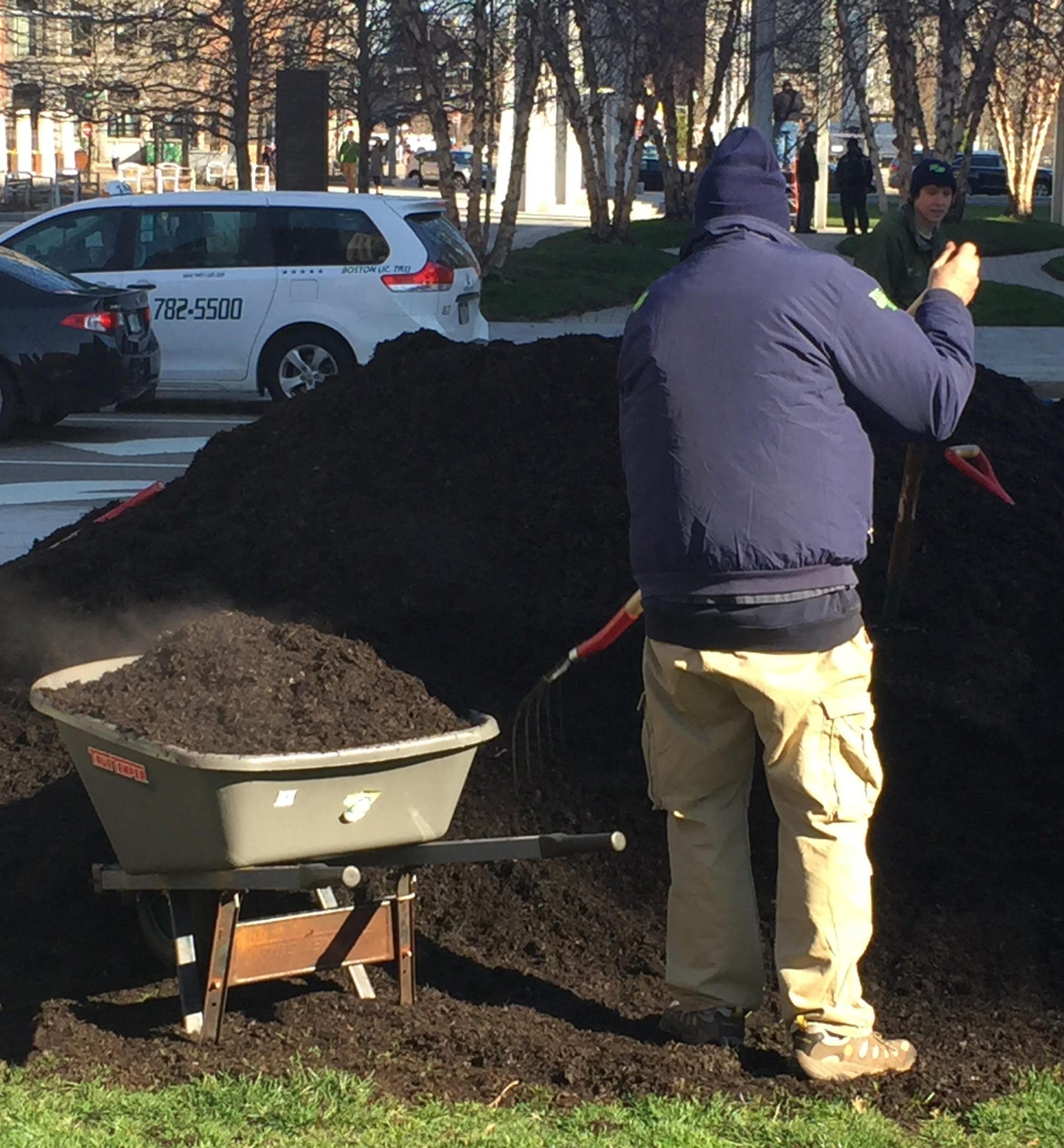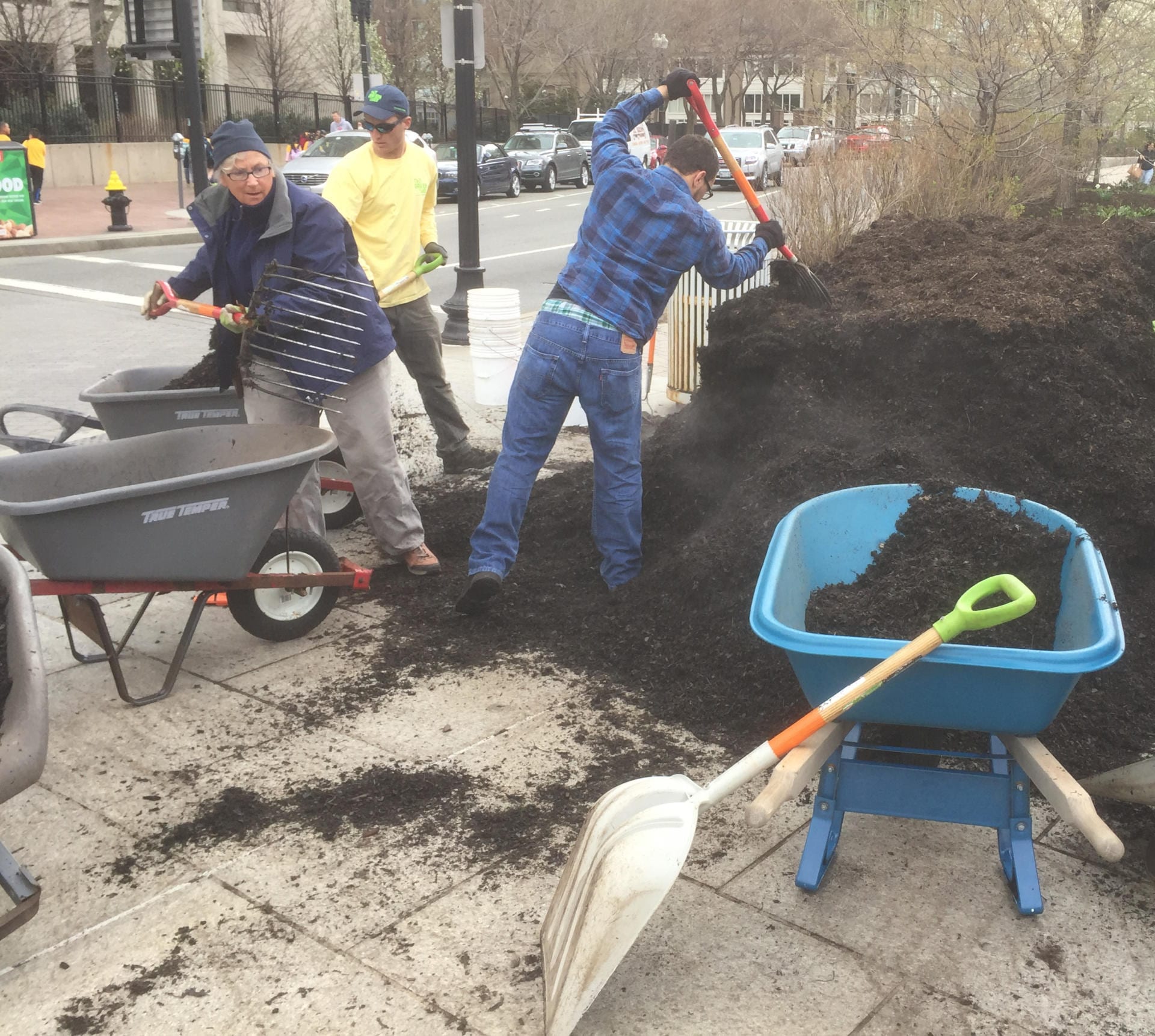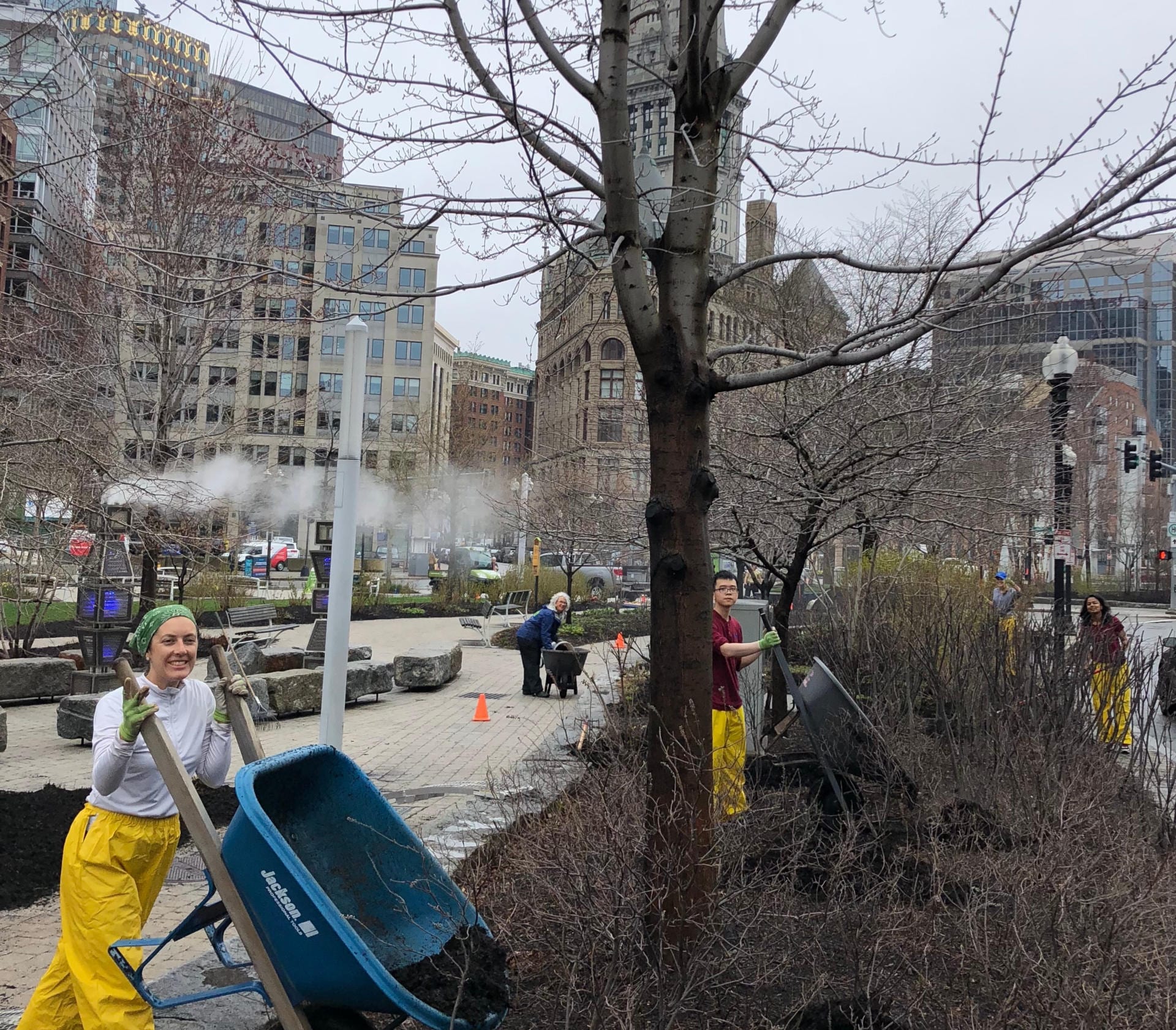by Darrah Cole and Anthony Ruggiero
Over the years the Rose Kennedy Greenway Conservancy, Boston, MA has worked to refine, simplify, and improve our organic, sustainable care routines across the 17 acres of The Greenway. Starting in 2010, we began mulching all our garden beds with a generous covering of a compost enriched, aged bark mulch after our regular spring cleaning. This mulch provides excellent moisture retention and weed suppression, while breaking down slowly to add much needed organic matter to our soils.
Throughout the Conservancy’s care and management of The Greenway, we have adjusted our annual garden bed management strategy to leave most perennial material up, and leaves in place, over the winter, removing less and less plant material from our beds in autumn. In the spring, perennials are cut back, beds lightly cleaned, and our usual bark/compost mulch blend applied. Choosing to leave this biomass up and in place over the winter season accomplishes a few things:
- Allows for natural decomposition to take place, recharging the soil and providing a food source for soil borne microorganisms.
- Provides habitat to sustain overwintering beneficial insects and pollinators.
- Reduces labor hours by lessening the volume of material that we remove from our beds each year. Time saved can be diverted to accomplish other horticultural priorities.
Investigating Leaf Mulch
In 2016 we started exploring leaf mulch, also called leaf mold, as an alternative. This is a product made locally by grinding up leaf debris collected from fall cleanups and composting it, usually in windrows, for one winter season. By mid to late spring it is ideally a fluffy, partially decomposed, chocolatey brown, fine textured mass alive and active with aerobic bacteria, fungi, and other organisms. In evaluating its use, we looked at the positive benefits and possible negative attributes of changing to a leaf mold from our compost/bark blend mulch.
On the positive side, leaf mulch mimics more closely the natural cycles that occur in untended forest and grassland ecosystems. Each year in these settings, leaves fall off trees and herbaceous material dies back, accumulating on the ground. This material is much different from most landscape mulches, which consist of predominantly woody products. The debris that accumulates on the ground is broken down by various microorganisms and macroorganisms, supporting the soil life we encourage. As these soil microorganisms further break down the soil organic matter, they also feed off each other, providing nutrients and helping to create healthy growing conditions for the plant material in our gardens. This natural soil cycle is called the Soil Food Web, and it is critical for us because much of our organic approach is built around healthy, vital, and active soil biology.

Steam rises from warm leaf mulch on a cool day. Staff and volunteers are almost finished with the 20 yard delivery.
Setting up a Trial
We chose to trial the use of leaf mulch exclusively in the Wharf Park and other areas of our Pollinator Ribbon. These are sections of the Greenway planted with North Eastern American native plants, and they generally have a more relaxed design. The 2 to 4 inches of leaf mulch we apply to these beds provides moisture retention and good weed suppression, in addition to readily available organic matter that helps create a healthier soil ecosystem closely related to the natural conditions these plants grow in. Soil tests have shown a noticeable improvement in both organic matter (OM) and cation exchange capacity (CEC) in beds where we use leaf mulch. One test taken in fall 2015 showed OG at 7.3 percent, and the same bed tested in fall 2018 was up to 12.3 percent organic matter. This same sample showed a CEC in 2015 of 7.3 that climbed to 23.1 in the fall of 2018. A second test in another area saw the organic matter numbers go from 6 percent in 2015 to 9.5 percent in 2018 and the CEC improve from 11.1 to 17.2 in that three year span. These improvements in fertility are compelling, so much so that we now may need to monitor for soil that is becoming too rich for our native plant needs.
Our leaf mulch trial showed problems and drawbacks to consider as well. The leaf mulch is more labor intensive to use than the bark mulch, requiring hand labor to spread as it cannot be ‘blown’ into beds due to its ‘fluffy’ consistency. Our solution was pretty straightforward. We engage volunteer groups regularly to help us and they have proved very adept at moving and spreading leaf mold. This is a win-win – getting the task completed and sharing The Greenway with local communities and businesses at the same time.
In droughty hot summers, the leaf mulch has been prone to small fires, especially close to busy street areas where a tossed cigarette butt can create a smoldering fire. These have been easily controlled with quick observation and good communication. This situation would be less common in residential applications than in a bustling urban park.
We also realize that over time the leaf mulch will continue to add to soil fertility. Eventually, we may be creating too rich of a soil for some of our native plants that prefer leaner soil.
As we do with all of our land care management practices at the Greenway Conservancy, we will continue to reassess, research, experiment, and adapt our use of mulches as the needs of the park change over time.
About the Authors
Darrah Cole is Senior Horticulturist and Designer at The Greenway, a ribbon of parks running through the city of Boston. Before joining the Conservancy staff in 2011, Darrah managed private, historic estate gardens in Maine and Massachusetts and worked at Heronswood Nursery in Kingston, WA. She has actively employed organic growing methods professionally since 1995 and maintains AOLCP and MCH certifications.
Anthony Ruggiero, Horticulture Foreman, joined the Greenway Conservancy in June 2009, with a strong passion for Sustainable/Organic Land Care. He is responsible for the direct oversight of the Horticulture crew and the day-to-day horticultural activities on the Greenway, as well as for the management of the Greenway’s Organic Program and Irrigation Systems. Anthony’s previous experience includes working in all aspects of the Green industry, he specializes in Sustainable/Organic Land care. He holds an Associate’s degree in Turfgrass Management from Stockbridge University, a Bachelor’s degree in Plant and Soil Science from UMass Amherst, and is a certified AOLCP.
***
Each author appearing herein retains original copyright. Right to reproduce or disseminate all material herein, including to Columbia University Library’s CAUSEWAY Project, is otherwise reserved by ELA. Please contact ELA for permission to reprint.
Mention of products is not intended to constitute endorsement. Opinions expressed in this newsletter article do not necessarily represent those of ELA’s directors, staff, or members.





